|
It was a summer's evening. The war
might be raging all around the globe; but here in
this house in
Streetly we were protected by the might of the
32nd Staffordshire
(Aldridge) Battalion and, at that moment, all was quiet. I had
finished playing and was now enthroned in the smallest
room of the house, my short trousers at my ankles
and my feet still several years away from reaching
the floor. The latest issue of "Comic Cuts"
lay on my knees and I was totally engrossed and at
peace with the world.
It was not only the loudness of the
nearby bang which shocked me but also the fact that
it was utterly unexpected. Its impact on me was so
great that I fell sideways off the seat and found
myself on the lino floor, firmly wedged between wall
and pedestal. Adjusting my attire only sufficiently
to enable me to run, I rushed out of the lavatory
and across the landing, past the familiar group of
anti-incendiary sand and water buckets and into my
parents' bedroom at the back of the house. There the
window was wide open. Sitting on the windowsill and
gripping the frame with his left hand to steady himself,
my father was leaning out as far as he could, his
right arm outstretched as he again took aim with his
revolver at some hidden target.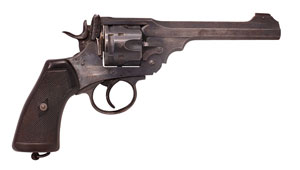 As I approached the
window I saw that the intended victim, a surprisingly
nonchalant rabbit, was still munching away on our
neighbour's lawn. I was waved away to a safe distance
and told to cover my ears. My father's second shot
was no more successful and at that point he abandoned
the hunt and pulled himself back into the room. The
target meanwhile twitched his nose and ambled off
into an overgrown border. We would be having corned
beef again tomorrow night, and not one of those tasty
rabbit stews. As I approached the
window I saw that the intended victim, a surprisingly
nonchalant rabbit, was still munching away on our
neighbour's lawn. I was waved away to a safe distance
and told to cover my ears. My father's second shot
was no more successful and at that point he abandoned
the hunt and pulled himself back into the room. The
target meanwhile twitched his nose and ambled off
into an overgrown border. We would be having corned
beef again tomorrow night, and not one of those tasty
rabbit stews.
It is hard in the 21st century to
envisage the exposure to weaponry and other things
that went "bang" which almost everyone sixty-five
years ago took as a matter of course. Now, of course,
swingeing laws have concentrated gun ownership in
the UK almost completely into the hands of a tiny
but dangerous minority who have more incentive to
flout the law than to obey it. But then, and especially
if one lived in a Home Guard household as I did, lethal
weaponry was as much part of one's daily life as the
radio set in the living room or the dresser in the
kitchen. As my father eased himself off the windowsill
on that summer's evening, no armed police response
unit with blaring sirens was on its way to surround
the house nor any complaining neighbour hammering
on the door. He took the remaining cartridges out of
the chamber, cursed the rabbit in restrained language
suitable for my ears, smiled complicitly in my direction
and put the revolver, no doubt a
Webley of some sort,
back into its drawer.
I already knew where that revolver
lived when it was not in its holster at my father's
waist. It nestled in the top drawer of a chest-of-drawers
amongst his vests, pants and starched collars, and
was accompanied by several small cartons of ammunition.
Perhaps fortunately I was not a particularly adventurous
or boastful child or I might have been tempted, when
the opportunity arose, to extract it from the drawer
and show it off to my young playmates. That thought
is frightening. But even then I knew the basic rule
of handling a weapon: that one never, never pointed
it at anyone even if one was absolutely certain that
it was not loaded. I remember the lesson well. I think
it was my elder brother who felt that my brandishing
of his Home Guard rifle was in danger of transgressing
that golden rule. I was about six at the time.
I only recall seeing the revolver
fired on one other occasion. On a wintry Sunday morning
my father took me to a field behind
Cutler's Garage
in Streetly. There he met up with some of his comrades
and a large sheet of thin steel or perhaps aluminium.
I imagine the metal was to be used for some defensive
purpose, possibly the protection of a vehicle. The
sheet was propped up against a bush and all of us
except for my father retired to a safe distance. I
was told to cover my ears; my father raised his Webley,
took aim at the middle of the sheet and pulled the
trigger. The target this time was of course a little
more difficult to miss. We then gathered around it
and balefully examined the damage. The experiment
was deemed a success as the sheet, whilst severely
dented, had not been penetrated. It was then carried
off towards the garage and we all went our separate
ways. Thirty years later the script of "Dad's
Army" would have concluded this little episode
with Warden Hodges tearing across the field in our
direction, puce-faced under his ARP helmet, shaking
his fist and shouting "Ruddy 'ooligans!!"
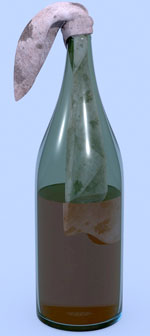 There were of course plenty of other
items within my horizons which were also designed
to detonate in one way or another. I have a dim memory
of a line of recently prepared
Molotov cocktails
(left)
in our back garden but such basic devices were
eventually superseded by more sophisticated methods of
defending the realm. Particularly familiar to me in
our home, perhaps because they became mementos at the
end of Home Guard activities, were at least three
types of grenade. There were of course plenty of other
items within my horizons which were also designed
to detonate in one way or another. I have a dim memory
of a line of recently prepared
Molotov cocktails
(left)
in our back garden but such basic devices were
eventually superseded by more sophisticated methods of
defending the realm. Particularly familiar to me in
our home, perhaps because they became mementos at the
end of Home Guard activities, were at least three
types of grenade. The most familiar was the
Mills bomb
in various forms, all shaped like a pineapple and
usually the No. 36
(on the extreme
right in this group).
I was taught at quite an early age how to throw that
correctly: the bomb in one's throwing hand held out
straight behind one, the free arm held out equally
straight in front, and then the throwing in a sort
of cartwheeling motion. There was the sticky bomb,
a smallish black or brown globe with a straight handle emerging
from it. This, I was assured, The most familiar was the
Mills bomb
in various forms, all shaped like a pineapple and
usually the No. 36
(on the extreme
right in this group).
I was taught at quite an early age how to throw that
correctly: the bomb in one's throwing hand held out
straight behind one, the free arm held out equally
straight in front, and then the throwing in a sort
of cartwheeling motion. There was the sticky bomb,
a smallish black or brown globe with a straight handle emerging
from it. This, I was assured,
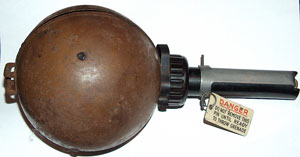 was designed to break
on impact, exude a sticky substance and thereby adhere
to its target before exploding. It all sounded a little
unlikely and haphazard to me, as it did no doubt to
those who were trained on it. And then there was a
smaller cylindrical device, rather like a miniature
thermos flask, in black metal or plastic
(below). I have only
recently managed to give these last two their correct
names, the No. 74 ST Grenade was designed to break
on impact, exude a sticky substance and thereby adhere
to its target before exploding. It all sounded a little
unlikely and haphazard to me, as it did no doubt to
those who were trained on it. And then there was a
smaller cylindrical device, rather like a miniature
thermos flask, in black metal or plastic
(below). I have only
recently managed to give these last two their correct
names, the No. 74 ST Grenade
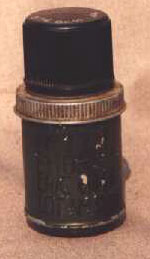 and, most probably, the
No. 77 Smoke Grenade respectively. But it was always
the Mills bomb that seemed to me to be the real weapon
in this trio, a feeling reinforced for me when I heard
my father recounting the incident, mentioned somewhere
in "Home Guarding", when a live grenade,
the pin removed and ready to be thrown, was accidentally
dropped in a 32nd Battalion training trench.
(This incident
is mentioned
elsewhere
in this website). All three
of these devices ended up as ornaments on the plate
shelf in our hall after the war and remained there
for several years, no doubt promoting many memories
for my father and sideways glances from visitors.
I have every confidence that his assurance - that
they were blanks and merely training tools - was wholly
valid. and, most probably, the
No. 77 Smoke Grenade respectively. But it was always
the Mills bomb that seemed to me to be the real weapon
in this trio, a feeling reinforced for me when I heard
my father recounting the incident, mentioned somewhere
in "Home Guarding", when a live grenade,
the pin removed and ready to be thrown, was accidentally
dropped in a 32nd Battalion training trench.
(This incident
is mentioned
elsewhere
in this website). All three
of these devices ended up as ornaments on the plate
shelf in our hall after the war and remained there
for several years, no doubt promoting many memories
for my father and sideways glances from visitors.
I have every confidence that his assurance - that
they were blanks and merely training tools - was wholly
valid.
I was a little less confident about
such assumptions on one occasion when I was taken
to Little Aston Hall Stables where "B" Coy.
had its H.Q. I believe we were going to collect something.
My father opened the door of a
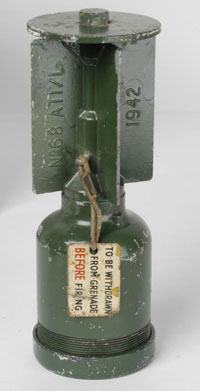 cupboard and before
he could catch it, out from the top shelf rolled a
fearsome looking piece of weaponry. With hindsight
it was most probably a
No. 68 Anti-Tank Grenade of
the type which caused consternation in another
32nd
Battalion memoir in this website entitled "The
Wots-Its-Name Bomb". This thing thudded onto
the cobbled floor, bounced, rolled a few feet and
came to rest. My father picked it up, stuffed it back
into the cupboard and closed the door on it. Nothing
was said. I felt it must be another blank round. He
no doubt knew that for certain. Didn't he? cupboard and before
he could catch it, out from the top shelf rolled a
fearsome looking piece of weaponry. With hindsight
it was most probably a
No. 68 Anti-Tank Grenade of
the type which caused consternation in another
32nd
Battalion memoir in this website entitled "The
Wots-Its-Name Bomb". This thing thudded onto
the cobbled floor, bounced, rolled a few feet and
came to rest. My father picked it up, stuffed it back
into the cupboard and closed the door on it. Nothing
was said. I felt it must be another blank round. He
no doubt knew that for certain. Didn't he?
It was however the rifle which was
always most in evidence and remains clearest in my
memory. I am certain that my father's personal weapon
was a .303 Lee Enfield, rather than the American .300
with which the Battalion was also equipped and which
were painted with a distinctive red band to ensure
that the right ammunition was used. In the intervals
between button and boot polishing I became expert
in its maintenance, wielding oily rags and various
pull-throughs like a veteran of the Western Front.
I was also proud of my ability to hold and aim the
weapon correctly whilst prone on my front - elbows
 and legs well apart, the rifle firm and steady, eye
looking down the barrel and lining up the rear and
front sights. An old Birmingham friend of my father's,
another Great War survivor and Home Guard enthusiast,
was mightily impressed - or so he kindly told me -
when I decided unprompted to use his personal weapon
in order to demonstrate my skill on his lounge carpet
in King's Norton. and legs well apart, the rifle firm and steady, eye
looking down the barrel and lining up the rear and
front sights. An old Birmingham friend of my father's,
another Great War survivor and Home Guard enthusiast,
was mightily impressed - or so he kindly told me -
when I decided unprompted to use his personal weapon
in order to demonstrate my skill on his lounge carpet
in King's Norton.
I was of course never allowed to
fire the rifle. I imagine the only reason for that was
that I was not considered strong enough to cope with
the recoil. Had I been allowed, I would not have had
to wait another ten or twelve years, and my own
National Service, to learn that it is one thing to
hold and aim a .303 in the approved manner but
entirely another to hit a small target a couple of
hundred yards away. My father on the other hand was a
good marksman and won various Home Guard competitions.
I had to be content with an air pistol, on the couple
of occasions when I could persuade an uncle to let me
borrow it, which I used in totally unsuccessful
attempts to reduce the Herefordshire rabbit population
in the summer of 1943 or 1944; whilst at my side my
father was striving to do the same thing with another
item from his armoury, a lethal .22 rifle with a range
of about a mile. I did on the other hand see the Home
Guard weapons fired, I think at a range located in a
sandpit up Little Hardwick Road,
Streetly. On one occasion a machine gun was also being
used firing tracer bullets. The target was a battered
oil drum and I remember being impressed with the way
in which this chunk of metal rapidly glowed red hot
as the bullets thudded into it.
Of course to a small boy all this
contact with grown-ups' weaponry was a source of continuing
interest and excitement. I was not imaginative enough
to sense that to thousands, if not millions of my
contemporaries across continental Europe and Asia
such familiarity was during those years anything but
fun. But then I already knew that the world was a
ghastly, cruel place, with the aim of every single
German and Japanese being to kill me if they had the
opportunity; and so, even if I had thought about it,
I would probably have regarded it as just another
facet of all that distant brutality and horror which
was the norm, shrugged my shoulders and continued
polishing the brasswork on my father's webbing.
But eventually it all started to come
to an end. When the Home Guard was stood down in December
1944 various redundant items of which my father was
custodian were disposed of in different ways. These
included a couple of cartons of smoke bombs and some
Sten gun components whose final resting place would
probably have fallen marginally short of 21st century
environmental recommendations. But somehow or another
my father's official rifle never quite got handed
in at that time. By then it had been joined by an
American .300 with its red band and a German rifle
of unknown provenance which he always described as
having a kick like a mule. Their home was a corner
at the back of his wardrobe. There they stayed, increasingly
illegally, for thirty years until his death in 1974.
My mother was probably relieved to have the opportunity
of disposing of them at that time and contacted the
local police for assistance. My father's treasures
were gingerly carried out of the house in
Chester Road,
Streetly under a blanket
by a young constable and disappeared to an unknown
fate. Whether they were accompanied by the revolver,
the .22 rifle, the 12-bore shotgun, the necessary
ammunition and any other weapon of which I was unaware,
I do not know; but in case any beady eye of authority
should fall upon this page I should perhaps confirm
that this residual armoury never passed into my possession.
Neither then nor later! My mother was advised that
in the circumstances the police would not be pressing
charges. Which I thought was jolly decent of them.
CM (Webmaster)......... September 2005
© staffshomeguard.co.uk 2005
|